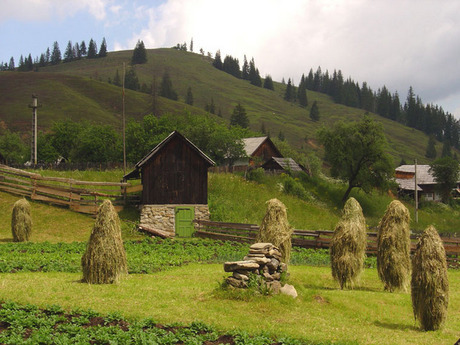Bucovina
Bukovina is a historical region on the northern slopes of the northeastern Carpathian Mountains and the adjoining plains. It is currently split between Romania and Ukraine. Bucovina is one of the most attractive and visited touristic areas in Romania. No wonder this area(famous today all over the world) was given in 1975 the Pomme d’Or international prize by The International Federation of Travel Writers and Tourism Journalists. The century-old architecture monuments together with the frescos from this country spot were listed by UNESCO among all the universal art monuments.
Keeper of ancient civilization, where history and legend merge together, Suceava district holds evidences of man’s presence from ancient times.The 96 incineration tombs found out at Zvoristea, as well as the archaeological discoveries in Silistea Scheii, Suceava , Bosanci and Dolhestii Mari, prove that Thracian–Geta and Dacian settlements existed there a long time ago.
The name Bukovina came into official use in 1775 with the region's annexation from the Principality of Moldavia to the possessions of the Habsburg Monarchy, which became Austrian Empire in 1804, and Austria-Hungary in 1867.
The official German name, die Bukowina, of the province under Austrian rule (1775–1918), was derived from the Polish form Bukowina, which in turn comes from the common Slavic form Bukowina, which stands for beech tree as, for example, in Ukrainian or, even, Buche in German).
The lands of Suceava represented the places where Moldavia became an independent and feudal state in the 14th century. Locations such as Baia, Siret, Suceava, Radauti still keep edifices (fortresses, church foundations, princely homes) dating the time of the first Moldavian voivods. Other localities, such as Putna, became a strong manifestation for Romanian people’s sense for an united nation. To this common sense many important persons contributed: Mihai Eminescu, Mihai Slavici, Ciprian Porumbescu and some other young people that came here all over Romanian lands. This fact strongly expresses the active role the people from these lands have played along the history.
Bucovina is known for its folk costumes, furniture, pottery, tapestries and carpets. The craftsmen continue the traditions handed down from generation to generation. Masks, traditional costumes, painted eggs, carved wooden objects, embroideries and carpets are still part of daily life.
Woodworking is much appreciated in Bucovina, where the material is plentiful. It is used for most household objects, as well as building the houses. The different parts of the house are decorated with carvings, such as the pillars of the veranda or the farmyard gate. The dowry includes, apart from the trousseau of textiles, also carved wooden cups, spoons, barrels, ladles and pots.
An ancient occupation in the zone is the making of pottery. There are two well-known centers of workshops, Rădăuţi and Marginea, but also Boroaia and Dolheşti are worth a mention. The potters of the Magopăţ family in Marginea and those of the Colibaba family in Rădăuţi are famous everywhere for their skills.
Bucovina is one of the few regions where the tradition of painted Easter eggs is still alive. The biggest and hardest eggs are turned into real masterpieces of intricate patterns in green, red, blue, black and yellow. In Brodina, Izvoarele Sucevei, Suceviţa, Breaza, Moldova Suliţa and Ulma egg painting is one of the main occupations of women.
The offer of accommodation is varied and there is something for the budget of every traveler. There are modern luxurious hotels fulfilling Western standards, tall concrete blocks dating from the communist period, old-fashioned pensions, new villas and casas, which are small private hotels, and rooms in a farmhouse.
The architecture in Bucovina, as well as in all of Romania, is a mix of old and new architecture, but very often hotels are found in anonymous modern buildings. All hotels are classified according to a national system, going from one to five stars.
Anyone wanting to experience the region first-hand and eager to see how a Bucovinean household is, should stay at a farmhouse in what the Romanians call agroturism. One can find sings of cazare (rooms) in any of the villages near the monasteries. These are normal homes with some rooms that are rented out. The rooms are warm and clean, but often not equipped with any extra comfort, such as private bathrooms. Upon request, the owners can prepare dinner. The prices are very low, but change according to the season in the most popular villages. With less than 10 €/day one can have board and lodging in interesting surroundings. The old hotels built in the 1970’s or 80’s usually have two stars. In Suceava there are the Bucovina Severin, Continental (Arcaşul), Suceava and Balada hotels right in the centre of the town. In Câmpulung Moldovenesc can be found the Zimbru and Carpaţi hotels, in Fălticeni the hotel Turist, and in Vatra Dornei the Călimani and Dorna hotels. All these are near the centre, but quite anonymous compared with the newer private hotels. The price per night varies between 10 euro and 50 euro including breakfast, depending on the comfort and the number of beds in the room.
The “casas” or “vilas” are mostly modern houses on two levels, with their own heating system, restaurant and good quality service. They are graded from two to four stars, and the price is directly proportional to the services they offer. The best ones can have a sauna, swimming pool, bar, common room with a fireplace or a library. The prices range from 30 € to 50 € per night. All have a restaurant and offer good food.




